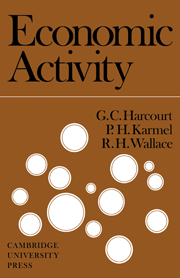Book contents
- Frontmatter
- Preface
- Contents
- 1 INTRODUCTION
- 2 THE NATIONAL ACCOUNTS AND THE INCOME–CREATION PROCESS
- 3 THE PRODUCTION–INCOME–EXPENDITURE CIRCUIT AND NATIONAL ACCOUNTING IDENTITIES
- 4 THE DETERMINATION OF THE EQUILIBRIUM LEVEL OF REAL INCOME
- 5 THE CONCEPT OF FULL EMPLOYMENT
- 6 MONEY IN THE ECONOMIC PROCESS
- 7 THE BANKING SYSTEM AND THE QUANTITY OF MONEY
- 8 THE CONSUMPTION FUNCTION
- 9 THE DETERMINANTS OF INVESTMENT EXPENDITURE
- 10 THE EFFECT OF CHANGES IN EXPENDITURE PLANS: THE MULTIPLIER CONCEPT
- 11 THE GOVERNMENT SECTOR AND THE DETERMINATION OF REAL INCOME
- 12 THE OPEN ECONOMY
- 13 THE INTERACTION BETWEEN PLANNED EXPENDITURES AND FINANCIAL FACTORS
- 14 INFLATION
- 15 ECONOMIC POLICY
- List of suggested reading
- Index
11 - THE GOVERNMENT SECTOR AND THE DETERMINATION OF REAL INCOME
Published online by Cambridge University Press: 18 December 2009
- Frontmatter
- Preface
- Contents
- 1 INTRODUCTION
- 2 THE NATIONAL ACCOUNTS AND THE INCOME–CREATION PROCESS
- 3 THE PRODUCTION–INCOME–EXPENDITURE CIRCUIT AND NATIONAL ACCOUNTING IDENTITIES
- 4 THE DETERMINATION OF THE EQUILIBRIUM LEVEL OF REAL INCOME
- 5 THE CONCEPT OF FULL EMPLOYMENT
- 6 MONEY IN THE ECONOMIC PROCESS
- 7 THE BANKING SYSTEM AND THE QUANTITY OF MONEY
- 8 THE CONSUMPTION FUNCTION
- 9 THE DETERMINANTS OF INVESTMENT EXPENDITURE
- 10 THE EFFECT OF CHANGES IN EXPENDITURE PLANS: THE MULTIPLIER CONCEPT
- 11 THE GOVERNMENT SECTOR AND THE DETERMINATION OF REAL INCOME
- 12 THE OPEN ECONOMY
- 13 THE INTERACTION BETWEEN PLANNED EXPENDITURES AND FINANCIAL FACTORS
- 14 INFLATION
- 15 ECONOMIC POLICY
- List of suggested reading
- Index
Summary
Introduction
The analysis of the process of the determination of real income in the simplified economy comprising only households and trading enterprises has been used to establish two basic propositions. First, that in the short run, the level of economic activity (and the extent of unemployed resources) are determined by the level of aggregate demand. And, secondly, that an autonomous increase in aggregate demand causes a change in real income which exceeds the autonomous increase by the amount of induced consumption expenditure. This latter is in turn limited by the proportion of the increased income allocated for saving, that is, the leakage from the income–expenditure circuit.
In this and the following chapter the role of the government and the oversea sectors is considered. The basic approach remains the same. The level of income is shown to be determined by aggregate demand, which, in the full economy, comprises planned expenditure upon domestically produced goods, net of their import content, by the public sector and oversea buyers, as well as by the private domestic sectors. It is shown that because taxation and purchases of goods from overseas do not give rise to demand for domestic production, they are leakages in the same sense as is saving.
Initially the argument assumes that the marginal propensity to consume is constant and identical for each income group. This means that it is not necessary to consider the distribution of personal disposable income as a specific factor determining aggregate demand.
- Type
- Chapter
- Information
- Economic Activity , pp. 195 - 229Publisher: Cambridge University PressPrint publication year: 1967



